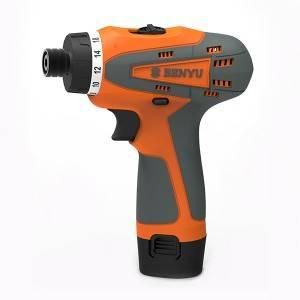A hand drill is a convenient, easy-to-carry CORDLESS SCREW DRIVER DZ-LS1002/12V tool, and consists of a small motor, a control switch, a drill chuck and a drill bit. In order to use this tool well, you do not need to understand its operating standards, but also need to understand its application precautions, and the wrong operation will constitute a loss. Follow the editor below to learn about the precautions and operating standards for the use of electric drills.
Operating Standard:
1. The casing of the electric hand drill is grounded or connected to the neutral line for maintenance.
2. The wire of the hand drill should be well maintained to prevent the wire from being damaged or cut by random dragging. It is not allowed to drag the wire into the oily water, and the oily water will corrode the wire.
3. Wear rubber gloves and rubber shoes when using it; when working in wet local areas, stand on rubber pads or monotonous wooden boards to prevent electric shock.
4. When the electric drill is found to be leaking, trembling, high heat or abnormal noise during use, it should work continuously and find an electrician to check and repair.
5. When the electric drill does not roll continuously, the drill bit cannot be unloaded or replaced. The power supply should be cut off when power outages rest or leave the work place.
6. It cannot be used to drill cement and brick walls. Otherwise, it is easy to cause the motor to overload and burn the motor. The key lies in the lack of impact organization in the motor, and the bearing force is small.
Use caution:
1. Selection criteria. Regarding different drilling diameters, the corresponding electric drill standard should be selected as far as possible.
2. Pay attention that the voltage should be consistent. When connecting with the power supply, pay attention to whether the power supply voltage is consistent with the rated voltage of the electric drill.
3. Check the edge resistance. For electric drills or new electric drills that are not needed for a long time, use a 500V insulation resistance meter to measure the insulation resistance between the winding and the casing before use. The resistance should not be less than 0.5Mf, otherwise it should be monotonic.
4. Drilling. The drill bit used is sharp, do not use too much force when drilling, and the electric drill is overloaded. When the speed suddenly drops. If the electric drill suddenly stops, the power should be cut off.
5. There should be protective insulation. Check whether the ground wire is excellent before use.
6. Idling test. Before use, it should be idling for 1min to check whether the work of the electric drill is normal. When the three-phase electric drill is tested, it is also necessary to check whether the rotation direction of the drill shaft is normal. If the steering is not correct, the three-phase electric wires of the electric drill can be exchanged at will to change the steering.
7. Precise orientation. When moving the electric drill, hold the handle of the electric drill, do not delay the power cord to move the electric drill, and the power cord may be scratched or crushed.
8. The electric drill should be handled lightly after use. Damage to the casing or other parts by impact.
Post time: Feb-14-2023

